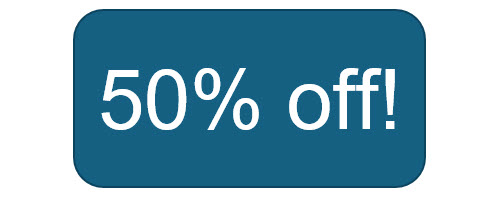
Working with percentages
Note: These lessons are excerpted from Luther Maddy’s Workbooks (C) 2024
Watch the Video
Working with percentages
Working with percentages
Percent literally means “part of 100”. Therefore, percentages can always easily be converted to decimal numbers in terms of 2 decimal places, or the 100th’s place. For example, 5% is 5 parts of 100 or .05.
When doing math with percentages, you must first convert them to the decimal equivalent. To do this, simply divide the percentage by 100. Remember the shortcut for doing this is to simply move the decimal point two places to the left. For example, 7.5% becomes .075
Percentages in business
Percentages are used almost everywhere in business. From interest rates to sales, consumers and business people will encounter percentages almost every day. Percentages are very important in business.
Since percentages are so important, being able to use them in math computations is also very important. You will encounter equations that add, subtract, multiply and even divide using percentages.
Computing a percentage of a number
To compute a percentage of a number, 5% of 20 for example, first convert the percentage into a decimal, then multiply that by the original number.
5% of 20 = .05 X 20 = 1
A shortcut for subtracting a percentage from a number
When you make a purchase on sale, you often receive a discount of a certain percentage. What is most important in this case is not necessarily how much of a discount you will receive, but how much the item will actually cost, after the discount has been subtracted.
For example, let’s assume a stereo normally sells for $125. The store is having a 15% off sale. The important question is how much will the stereo now cost.
Approach number 1: Find the discount amount, then subtract it from the original:
Discount = $125 X .15 = $18.75
Actual price = $125 – $18.75 = $106.25
Approach number 2: Find the actual price in one calculation by computing the percent of original price.
Percent of original price : 100% - 15% = 85%
Actual price is 85% of $125 or 125 X .85 = 106.25
When computing this in a spreadsheet you can do this in one formula such as:
Actual price = 125 X ( 100% - Discount%)
or 125 X (1 - .15) = 125 X .85 = 106.25
A shortcut for adding a percentage to a number
When you purchase some items at auction, for instance, the auction company may charge a premium, an added percentage to the price you agreed to pay for the item. In such a case, you’ll want to know how much you actually paid for the item.
A similar example is sales tax which is added to the purchase price. To know how much you need to write the check for, you need to be able to add a percentage to the original price.
For our example, assume you are purchasing a pair of shoes for $125. You need to know how much the shoes actually cost after you pay 6% sales tax.
Approach number 1: Find the added amount (Sales tax) then add it to the original:
Sales tax = $125 X .06 = $7.50
Actual price = $125 + $7.50 = $132.50
Approach number 2: Find the actual price in one calculation by computing the percent of original price.
Percent of original price : 100% + 6% = 106%
Actual price is 106% of $125 or 125 X 1.06 = 132.50
When computing this in a spreadsheet you can do this in one formula such as:
Actual price = 125 X ( 100% + added%)
or 125 X (1 + .06) = 125 X 1.06 = 132.50
Finding percents
Whether it be computing a markup on a selling item, or dividing up profits, it is often necessary to find percentages.
For example, let’s assume that a restaurant check for a group of people came to $56.00 and you threw $20 into the pot to pay for the meal. What percent of the entire check did you pay for: (20 is what percent of 56)? To do this, simply divide the portion by the total. You could even think of it as a fraction. You paid 20 / 56ths of the bill.
= 20 / 56 = .357 = 36%
If you are given a number and a percentage, such as 30 is 80% of what number, solve this by dividing the number by the decimal equivalent of the percentage:
30 ÷ .80 = 37.5
Finding Markup
In business, you may often need to find a percentage. For example, if you buy something for $40 and you sell that item for $60, you may want to know what your markup percentage is.
To do this, you must first decide if your markup is based on the selling price or based on the cost. First, we’ll find the markup based on the cost the retailer paid for the item.
1. Find the markup amount: 60 – 40 = 20
2. Divide the markup amount by the cost: 20 / 40 = .5 = 50%
If you want to find the markup based on the selling price, divide the markup amount by the selling price:
20 / 60 = .3333 = 33%
Sponsored Ads
2044
